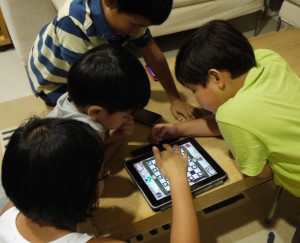
Is this time wasted or time to learn?
Although a small part of the behemoth gaming industry, educational games are expected to see healthy growth here in the U.S. and overseas over the next five years, according to new research.
Ambient Insight is still working on a more complete report that examines the full market for both educational games and simulation tools, but according to the independent research firm, the game-based learning industry, which reached $1.5 billion in revenues in 2012, will grow to $2.3 billion worldwide by 2017.
According to Ambient Insight’s Chief Executive Officer Tyson Greer, that growth is primarily from mobile games aimed at consumers rather than corporate or formal education markets.
“[W]ithin that market the highest revenues are coming from pre-K through three, early childhood education games which parents are buying,” Greer said.
Listen to more of the interview:
She added that they have discovered that this early education market paired with a large corporate training and “brain-training” market for adults have created a “content trench” for games targeting later elementary school through college. Greer said this lack of educational games is a new gap in the market they expect to continue in the near future.
In the coming years, Greer said that the consumer market will continue to grow, fueled by the wide variety of topics and interests that market covers. She added the consumer market also lacks the more cumbersome purchasing systems that have dogged public school systems.
Still, Greer said, the consumer market for learning games is governed by certain critical rules – the rules of what parents want for their children.
“The things that you are interested in are the things that you buy,” she said of the consumer market. “The things that you want your children to learn are the things that you value,” adding that this reality has been behind the growth of nature learning apps from firms like the Audubon Society.
And investors seem to be agreeing with Ambient Insight’s vision of a growing consumer market. Greer’s colleague Sam Adkins told Venturebeat that of the 31 game-based learning companies that raised venture funding in 2012, 23 were mobile and 21 targeted consumers.
Still, this is not to say that schools are not getting into the action, but Greer cautioned that is a different market than the consumer-facing products.
“The things that they look at to be saleable are adherence to Common Core standards… It would be a smart business decision that if you are targeting schools that you align it with Common Core standards,” she said.
To succeed in this growing market of formal education, though, Greer cautioned a firm should consider the standards, how to gauge student knowledge and how a game fits into a teacher’s classroom.
You can’t just expect a lot of success by plopping down a consumer-ready product into a school. It has to be integrated with the teachers. Some of the suppliers are also offering as part of the product an assessment engine that informs the teacher how well each student is doing.
Some worry this leaves teachers largely out of the educational gaming revolution, pushing game companies to focus on the consumer games rather than helping classrooms benefit from the technology.
“Teachers are hesitant to bring games into the classroom, not because they question their effectiveness, but because of the costs involved. Instead, children are learning through edugames the most in the home, when parents purchase them,” wrote Carmel Deamicis earlier this month at PandoDaily.
Despite these worries, Greer did highlight what she called one of the “overlooked” areas of the market – teacher training – as another way in which gaming firms may be able to unlock the market potential of the American public school system.
But all of this may be too-U.S. centric anyway. As Greer’s team points out, the current buyers of learning games – in order: United States, Japan, South Korea, China, and India – will likely change in the coming years. Ambient Insight expects China to overtake the U.S. and India, Indonesia and Brazil to greatly expand their markets for educational games.
